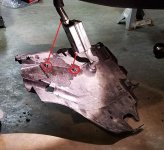Like many others, I'm pretty sure that this particular box is part of the charcoal canister/evaporative emissions collection system, so DGoebel, if yours is 'leaking' oil from inside its works, then you may have a bigger problem somewhere upstream!! :gaah:
I'd guess that if it IS oil dripping, then it's most likely on the outside of the fitting cos it's dripping down the outside of the hoses to the lowest/drip to ground point, & the oil is most likely coming from the fumes or condensate trapped/collected by the air filter & leaking out or it's leaking from a rocker gasket or similar somewhere! However, if it's coming from inside the box (breather/vent) then it is most likely gas (& that really hasta be the most likely scenario for anything coming from inside) - if it's gas dripping from outside the device, then it's possibly collecting inside the breather/vent as it should before a dodgy hose or join/clamp is letting it leak out before running thru the drain; otherwise it'll be collecting in the filter & 'venting' to the ground via the drain outlet just like it should! So hopefully, your drips aren't enough to be an issue, but regardless, with any luck it's gonna be oil on the outside of the box or gas on the inside of the box! :thumbup:
My 2013 RT Limited (with Heat Recall done) certainly has the drain hole in that RH Deflector plate like yours, & every once in a while I get a few drops of darkish fluid that feels/smells like gas collecting around the drain outlet - I'm pretty sure that it is just gas that's collected a few contaminants on the way thru the vent/breather system. At my last big service the fella's had a look at that specifically & were pretty sure all was working fine & not to worry about it! Not that I didn't believe them, but just for my peace of mind I collected some of the drops coming out of that drain/off the end of the deflector plate (in my case they do actually drip outta the drain but if I'm ryding when they do they will blow back along the underside of the plate & drip off the trailing edge!) :dontknow:Anyhow, once I had a few mls collected, I added a lit match to the fluid, knowing that if it was oil it wouldn't instantly ignite but that gas would - & the fluid instantly ignited!
You might want to try the same test, but beware, it is a bit of a pain collecting the drips, altho generally easier on a hot day shortly after filling the Spyder's tank with cool gas from an underground service tank & then ryding a bit to let it heat up to ambient temps & expel some fumes; then once collected, take the container you catch the fluid in FAR AWAY from anything flammable AND well away from your Spyder (I used an glass jar with an air-tight cap so I could collect a drop or two every time I stopped & not have the fluid evap away!) before applying that lit match to the open glass jar! And DO NOT under ANY CIRCUMSTANCES try applying the lit match directly to the drips as they are coming outta the drain on the deflector panel or its trailing edge! :lecturef_smilie: :shocked:
If your drips are gas like mine are, & there's a lot of them, then maybe you should try to avoid filling your Spyder's gas tank quite so full, or at least avoid leaving it parked in the sun while its got an almost full tank.... at the risk of telling some of you how to suck eggs, & specifically for those not aware of all this, that breather/vent shouldn't really get to vent liquid all that often/all that much, cos the evap system is designed to catch the EXCESS evaporative fumes that may be generated in the fuel tank on the odd occasion that the system isn't able to handle the volume in its normal manner by feeding them back into the air intake & burning them while the engine is running. It can handle the 'normal' amount of fumes that are generated while the engine is stopped, basically by collecting them & storing them until the engine is next running again, when they then get burnt by the engine as normal; but that drain & breather/vent system is there for the very few (or meant to be very few) times that the 'storage capacity' is overloaded & the system needs to dump condensate or start backing up pressure & possibly damaging things.... like popping a seal somewhere!! :shocked: The 'storage capacity' needed is very small, it doesn't need to be large to handle the tiny amount of fumes/condensate that might vent in the normal state of play. So if you try to avoid creating those 'abnormal loading' conditions then the drips will be minimised & then even if you get a few drops every now & then, it shouldn't ever be a problem! :thumbup:



